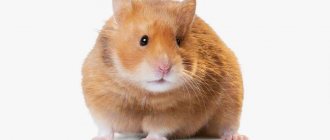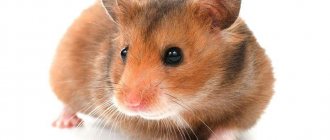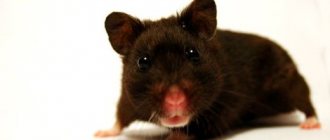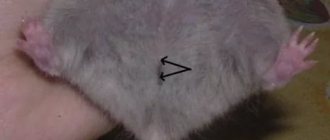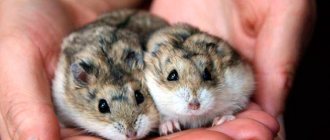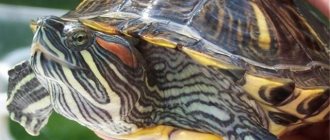Having made a deliberate decision to get a hamster at home, you must first make sure that your household members are not allergic to animal fur, choose the right place of residence for the future pet and study the rules for caring for it.
The hamster is a rather picky animal, but still requires careful care and attentive attitude towards itself.
Pros and cons of keeping a hamster at home
Before you get a pet hamster, you need to familiarize yourself with its main characteristics.
A convenient feature of this animal is that it is kept without a similar individual, that is, the hamster does not have to have a mate. He feels great alone, unless, of course, you are going to start breeding them.
The benefits of breeding a hamster at home are:
- small fluid intake, in case of taking juicy foods;
- keep the room quiet;
- the main difference from cats and dogs is the absence of rancor and resentment;
- have a positive attitude towards children;
- occupy a fairly small area;
- easy to train;
- breed in captivity;
- unpretentious in eating.
- in winter, the hamster can hibernate, and when it wakes up, it requires more food;
- constant care of the cage in which the animal is kept is necessary;
- It is necessary to keep a hamster only in a terrarium, otherwise it can ruin things;
- a hamster can be aggressive towards people.
Pregnancy and childbirth
Pregnancy in Syrian hamsters lasts 16-19 days. From 6 to 18 babies are born. Multiple pregnancy is associated with additional difficulties in feeding the offspring. It is difficult for a hamster to feed so many babies. Therefore, it is necessary to strictly monitor the quantity.
Keeping a hamster at home
Before getting a hamster, you need to carefully consider its habitat in the premises. A glass jar, aquarium or box will bring discomfort to the little resident.
For these purposes, it is wise to purchase a spacious iron cage (50 by 30 centimeters) with horizontal bars, the distance between which is not too wide so that the animal cannot get out of its home.
The resident needs to select additional special accessories for their new home:
- The bottom of the house must be filled with filler, which will help avoid unpleasant odors. It needs to be changed regularly, washing the cage thoroughly. The filler comes in pressed form and in granules. It is also wise to sprinkle some sawdust, which hamsters like to burrow into before going to bed.
- You need to place a couple of feeders in the cage: for natural food and for dry food.
- It is wise to hang a special drinking bowl for small animals on the bars of the house, the water from which will not flow out on its own.
- A running wheel will help an active animal spend time without being bored.
- To periodically sharpen sharp teeth, a mineral pebble is placed in the cage.
- The pet will choose the corner for the toilet itself; the toilet must be regularly replaced with fresh flooring.
General description of the breed
Roborovsky's hamster (Phodopus roborovskii) is the most striking representative of the dwarf breeds of the hamster family. Refers to the species of hairy-footed hamsters. Lives in Mongolia, adjacent areas of China and Russia. The body of adult individuals reaches a maximum length of 5 centimeters, weighing approximately 30 g. The species is named after the Russian naturalist V.I. Roborovsky. It is not particularly popular among breeders, because there is essentially nothing to breed. It's really very small. No fur from it, no meat... (just kidding). Look at the photo, isn't it cute?
This is how he is, a small and gentle animal, discovered by V.I. Roborovsky.
The hamster is very small. It does not have stripes on the back, characteristic of a number of other larger breeds, which is very clearly visible in the photo above.
One might get the impression that Roborovsky's hamster is tailless. In fact, every healthy animal has a tail. It’s just that the hamster is famous not only for its smallest body size, but also for its tiny tail. So tiny that it is practically invisible. It is well hidden somewhere in the fur, closer to the..., sorry, butt.
Pet hamster diet
If you still decide to get a pet, you need to know what a hamster eats several times a day. Since this animal is active at night, select the most high-calorie foods for its evening meal. To avoid poisoning, do not feed him excessively watery food (watermelon, melon, cucumber, etc.).
Approximately once a day you need to give your pet a special food made from a mixture of grains, the range of which is offered by specialized pet stores for animals.
The hamster usually determines the norm for one meal without anyone's help, but food must be constantly present, as well as the presence of fresh water. Don't forget to make sure your pet drinks enough throughout the day, this is a vital condition for hamsters!
Approximate diet for a domestic hamster:
- Vegetables and fruits, pitted.
- Potato.
- Grain mixture.
- Lean cooked meat.
- Seeds and nuts in small portions.
- Vitamin complex.
It is highly undesirable to feed your animal garlic and onions, citrus fruits and tropical foods.
Habitat of carbysh
The field hamster has a wide habitat. Mostly distributed in Central and Southern Europe, in the northwestern regions of China. The border of the rodent's range runs along the coasts of the Black and Azov Seas, moving to the lands of the western Ciscaucasia, crossing the Volga and going to Kazakhstan.
Countries where karbysh is protected by law:
- Germany;
- Netherlands;
- France;
- Ukraine;
- Russia;
- Poland;
- Belarus;
- Belgium.
The favorite places of residence of the wild karbysh hamster are forests and fields, mixed-grass meadows and steppes. The rodent loves to settle in dachas and vegetable gardens. Forest hamsters are not afraid of the proximity of people. If they do not have enough food, they may settle in living quarters.
The rodent is an animal that prefers a nocturnal lifestyle, practically not appearing on the surface during the daytime.
Photos of hamsters
Cow - description of appearance, diet, breed, interesting information + 109 photosChinchilla - breed classifications, fur features, care rules, nutrition and bathing + 94 photos

